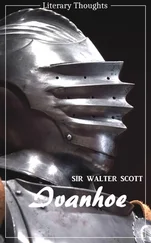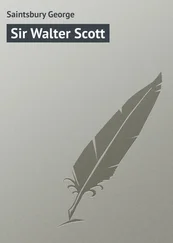First, as an instance of modern feeling for romance, this famous touch of the flageolet and the old song is selected by Miss Braddon for omission. Miss Braddon’s idea of a story, like Mrs. Todgers’s idea of a wooden leg, were something strange to have expounded. As a matter of personal experience, Meg’s appearance to old Mr. Bertram on the road, the ruins of Derncleugh, the scene of the flageolet, and the Dominie’s recognition of Harry, are the four strong notes that continue to ring in the mind after the book is laid aside. The second point is still more curious. The reader will observe a mark of excision in the passage as quoted by me. Well, here is how it runs in the original: “a damsel, who, close behind a fine spring about halfway down the descent and which had once supplied the castle with water, was engaged in bleaching linen.” A man who gave in such copy would be discharged from the staff of a daily paper. Scott has forgotten to prepare the reader for the presence of the “damsel”; he has forgotten to mention the spring and its relation to the ruin; and now, face to face with his omission, instead of trying back and starting fair, crams all this matter, tail foremost, into a single shambling sentence. It is not merely bad English, or bad style; it is abominably bad narrative besides.
Certainly the contrast is remarkable; and it is one that throws a strong light upon the subject of this paper. For here we have a man of the finest creative instinct touching with perfect certainty and charm the romantic junctures of his story: and we find him utterly careless, almost, it would seem, incapable, in the technical matter 147 of style, and not only frequently weak, but frequently wrong in points of drama. In character parts, indeed, and particularly in the Scots, he was delicate, strong, and truthful; but the trite, obliterated features of too many of his heroes have already wearied three generations of readers. At times his characters will speak with something far beyond propriety — with a true heroic note; but on the next page they will be wading wearily forward with an ungrammatical and undramatic rigmarole of words. The man who could conceive and write the character of Elspeth of the Craigburnfoot, as Scott has conceived and written it, had not only splendid romantic but splendid tragic gifts. How comes it, then, that he could so often fob us off with languid, inarticulate twaddle? It seems to me that the explanation is to be found in the very quality of his surprising merits. As his books are play to the reader, so were they play to him. He was a great daydreamer, a seer of fit and beautiful and humorous visions, but hardly a great artist. He conjured up the romantic with delight, but had hardly patience to describe it. Of the pleasures of his art he tasted fully; but of its cares and scruples and distresses never man knew less.
SCOTT AND HIS PUBLISHERS by Charles Dickens
Table of Contents
I
[March 31, 1839]
When the Refutation, to which this pamphlet1 is a reply, was put forth, we took occasion to examine into the nature of the charges of misstatement and misrepresentation which were therein brought against Mr. Lockhart, to point out how very slight and unimportant they appeared to be, even upon the refuter’s own showing, and to express our opinion that the refutation originated in the overweening vanity of the Ballantyne family, who, confounding their own importance with that of the great man who condescended (to his cost) to patronise them, sought to magnify and exalt themselves with a degree of presumption and conceit which leaves the fly on the wheel, the organ bellows-blower, and the aspiring frog of the fable, all at an immeasurable distance behind.
1 The Ballantyne Humbug Handled; in a letter to Sir Adam Fergusson. By the Author of Memoirs of the Life of Sir Walter Scott. Cadell, Edinburgh; Murray, London.
Much as we may wonder, after an attentive perusal of the pamphlet before us, how the lad, James Ballantyne’s son, can have been permitted by those who must have known from the commencement what facts were in reserve, to force on this exposure of the most culpable negligence and recklessness on the part of the men who have been paraded as the victims of erring and ambitious genius, it is impossible to regard the circumstance in any other light than as a most fortunate and happy one for the memory of Sir Walter Scott. If ever engineer were ‘hoist with his own petard,’ if ever accusations recoiled upon the heads of those who made them, if ever the parties in the witness-box and the dock changed places, it is in this case of the Ballantynes and Sir Walter Scott. And the proof, be it remembered, is to be found — not in the unsupported assertions of Mr. Lockhart or his ingenious reasoning from assumed facts, but in the letters, accounts, and statements of the Ballantynes themselves.
Premising that Mr. Lockhart, in glancing at the ‘ unanswerable
refutation’ and ‘the overwhelming exposure’ notices of the Ballantyne pamphlet in other journals, might fairly and justly have noticed this journal as an exception (in whose columns more than one head of his reply was anticipated long ago), we will proceed to quote — first, Mr. Lockhart’s statement of his reasons for introducing in the biography detailed descriptions of the habits and manners of the Ballantynes, which we take to have been the head and front of his offence; and secondly, such scraps of evidence bearing upon the allegation that the Ballantynes were ruined by the improvidence and lavish expenditure of Scott, as we can afford space for, in a very brief analysis of the whole.
With regard to the first point, Mr. Lockhart writes thus: — ‘The most curious problem in the life of Scott could receive no fair attempt at solution, unless the inquirer were made acquainted, in as far as the biographer could make him so, with the nature, and habits, and manners of Scott’s partners and agents. Had the reader been left to take his ideas of those men from the eloquence of epitaphs — to conceive of them as having been capitalists instead of penniless adventurers — men regularly and fitly trained for the callings in which they were employed by Scott, in place of being the one and the other entirely unacquainted with the prime requisites for success in such callings — men exact and diligent in their proper business, careful and moderate in their personal expenditure, instead of the reverse; had such hallucinations been left undisturbed, where was the clue of extrication from the mysterious labyrinth of Sir Walter’s fatal entanglements in commerce? It was necessary, in truth and justice, to show — not that he was without blame in the conduct of his pecuniary affairs — (I surely made no such ridiculous attempt) — but that he could not have been ruined by commerce, had his partners been good men of business. It was necessary to show that he was in the main the victim of his own blind over-confidence in the management of the two Ballantynes. In order to show how excessive was the kindness that prompted such over-confidence, it was necessary to bring out the follies and foibles, as well as the better qualities, of the men.”
Does any reasonable and dispassionate man doubt this? Is there any man who does not know that the titles of a hundred biographies might be jotted down in half an hour, in each and every of which there shall be found a hundred personal sketches of a hundred men, a hundred times more important, clever, excellent, and worthy, than Mr. James Ballantyne, the Printer of Edinburgh, and whilom of Kelso, regarding which the world has never heard one syllable of remonstrance or complaint?
Of Mr. John Ballantyne, the less said the better. If he were an honest, upright, honourable man, it is a comfort to know that there are plentiful store of such characters living at this moment in the rules of our Debtors” Prison, and passing through the Insolvent Court by dozens every day. As an instance of Mr. Lockhart’s easy mode of assertion, we were given to understand in the Refutation that Mr. John Ballantyne had never been a banker’s clerk. Mr. Cadell and another gentleman bear testimony that he used to say he had been (which seems by no means conclusive evidence that he ever was), and if he were, as Mr. Lockhart tells us he has since learnt, a tailor, or superintendent of the tailoring department of the father’s general shop at Kelso, a previously unintelligible fragment in one of Scott’s letters becomes susceptible of a very startling and simple solution. ‘If it takes nine tailors to make a man, how many will it take to ruin one?’
Читать дальше







